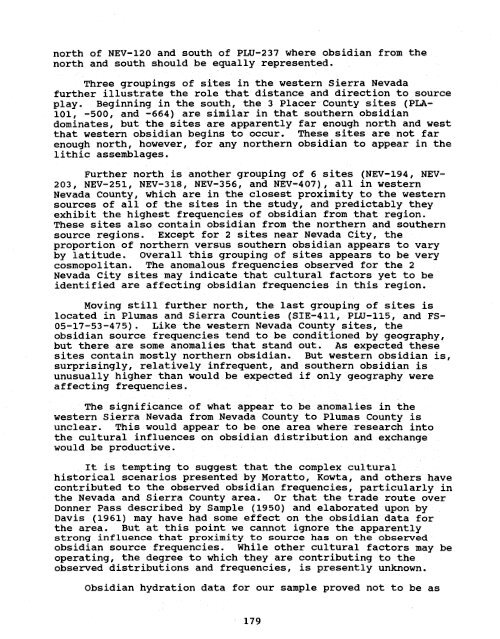regional prehistory and california-great basin - Society for California ...
regional prehistory and california-great basin - Society for California ...
regional prehistory and california-great basin - Society for California ...
You also want an ePaper? Increase the reach of your titles
YUMPU automatically turns print PDFs into web optimized ePapers that Google loves.
north of NEV-120 <strong>and</strong> south of PLU-237 where obsidian from the<br />
north <strong>and</strong> south should be equally represented.<br />
Three groupings of sites in the western Sierra Nevada<br />
further illustrate the role that distance <strong>and</strong> direction to source<br />
play. Beginning in the south, the 3 Placer County sites (PLA-<br />
101, -500, <strong>and</strong> -664) are similar in that southern obsidian<br />
dominates, but the sites are apparently far enough north <strong>and</strong> west<br />
that western obsidian begins to occur. These sites are not far<br />
enough north, however, <strong>for</strong> any northern obsidian to appear in the<br />
lithic assemblages.<br />
Further north is another grouping of 6 sites (NEV-194, NEV-<br />
203, NEV-251, NEV-318, NEV-356, <strong>and</strong> NEV-407), all in western<br />
Nevada county, which are in the closest proximity to the western<br />
sources of all of the sites in the study, <strong>and</strong> predictably they<br />
exhibit the highest frequencies of obsidian from that region.<br />
These sites also contain obsidian from the northern <strong>and</strong> southern<br />
source regions. Except <strong>for</strong> 2 sites near Nevada City, the<br />
proportion of northern versus southern obsidian appears to vary<br />
by latitude. Overall this grouping of sites appears to be very<br />
cosmopolitan. The anomalous frequencies observed <strong>for</strong> the 2<br />
Nevada city sites may indicate that cultural factors yet to be<br />
identified are affecting obsidian frequencies in this region.<br />
Moving still further north, the last grouping of sites is<br />
located in Plumas <strong>and</strong> Sierra Counties (SIE-411, PLU-115, <strong>and</strong> FS-<br />
05-17-53-475). Like the western Nevada County sites, the<br />
obsidian source frequencies tend to be conditioned by geography,<br />
but there are some anomalies that st<strong>and</strong> out. As expected these<br />
sites contain mostly northern obsidian. But western obsidian is,<br />
surprisingly, relatively infrequent, <strong>and</strong> southern obsidian is<br />
unusually higher than would be expected if only geography were<br />
affecting frequencies.<br />
The significance of what appear to be anomalies in the<br />
western Sierra Nevada from Nevada County to Plumas County is<br />
unclear. This would appear to be one area where research into<br />
the cultural influences on obsidian distribution <strong>and</strong> exchange<br />
would be productive.<br />
It is tempting to suggest that the complex cultural<br />
historical scenarios presented by Moratto, Kowta, <strong>and</strong> others have<br />
contributed to the observed obsidian frequencies, particularly in<br />
the Nevada <strong>and</strong> Sierra County area. Or that the trade route over<br />
Donner Pass described by Sample (1950) <strong>and</strong> elaborated upon by<br />
Davis (1961) may have had some effect on the obsidian data <strong>for</strong><br />
the area. But at this point we cannot ignore the apparently<br />
strong influence that proximity to source has on the observed<br />
obsidian source frequencies. While other cultural factors may be<br />
operating, the degree to which they are contributing to the<br />
observed distributions <strong>and</strong> frequencies, is presently unknown.<br />
Obsidian hydration data <strong>for</strong> our sample proved not to be as<br />
179
















